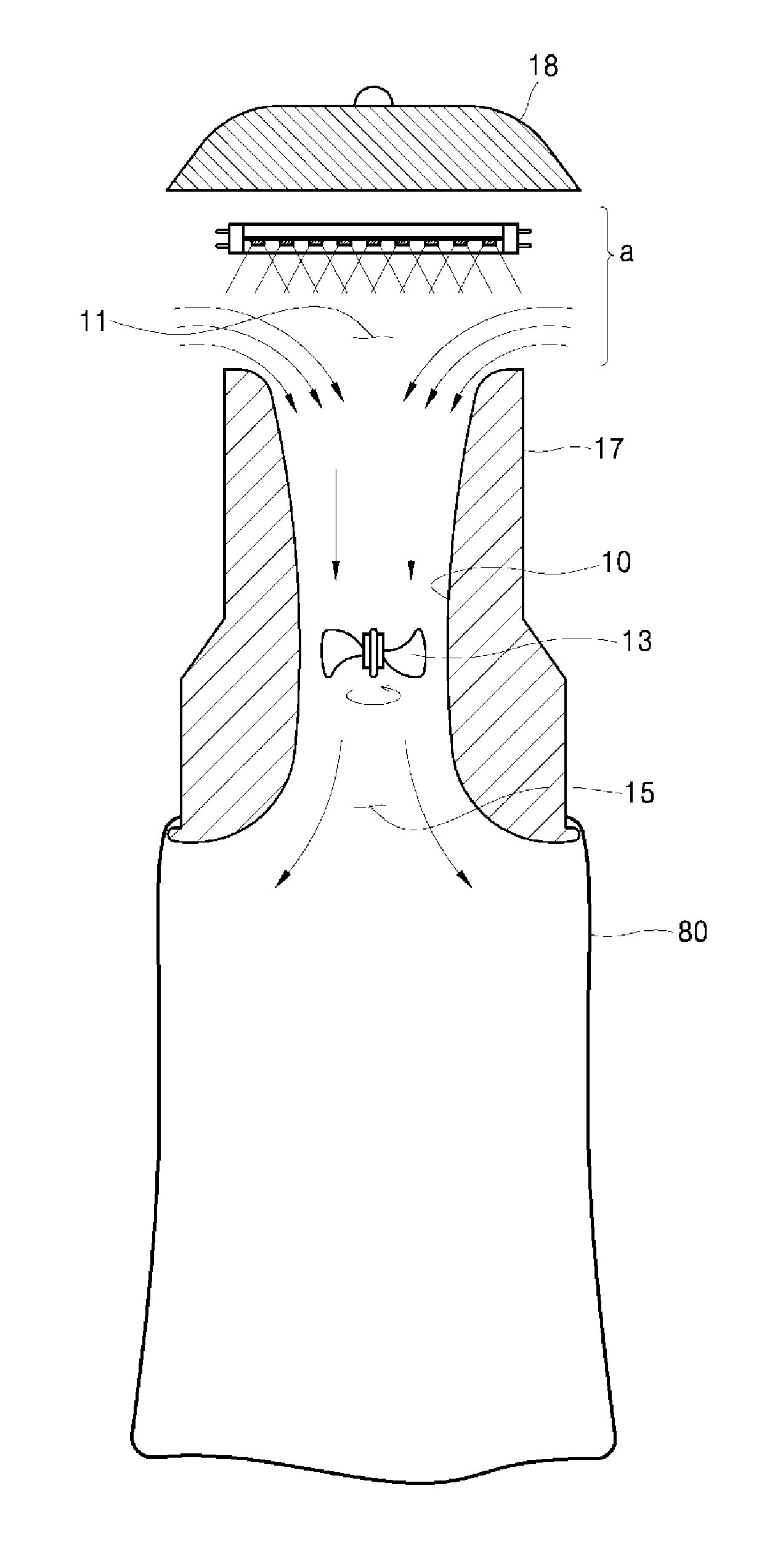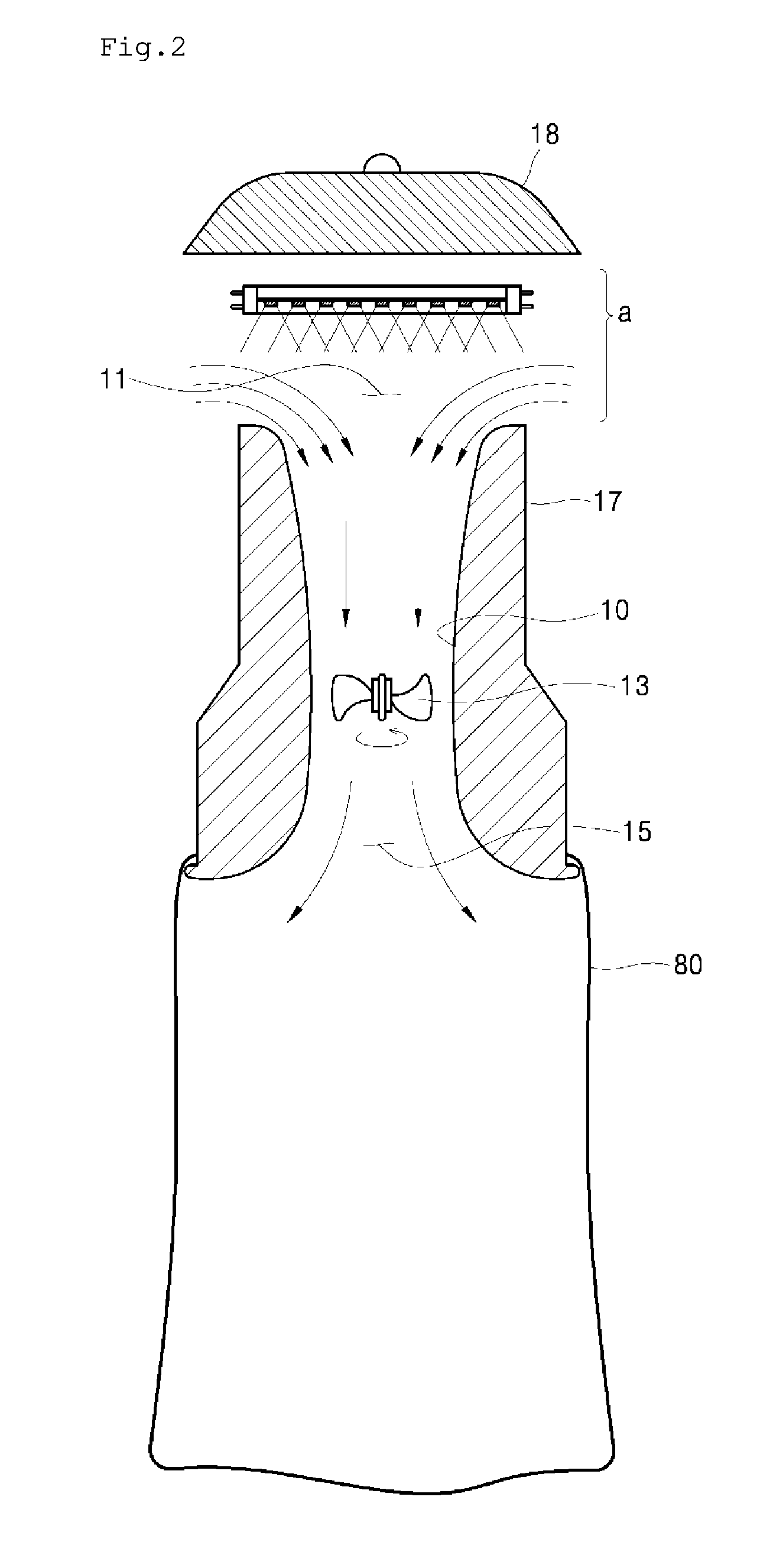Insect trap using UV LED lamp
a technology of ultraviolet light and insect trap, which is applied in the direction of insect traps and killers, semiconductor devices, electrical equipment, etc., can solve the problems of short span, high power consumption and heat generation, environmental pollution, etc., and achieve the effect of increasing the efficiency of insect trapping
- Summary
- Abstract
- Description
- Claims
- Application Information
AI Technical Summary
Benefits of technology
Problems solved by technology
Method used
Image
Examples
1st embodiment
[0047]FIG. 1 is a side view of an insect trap according to the present disclosure, FIG. 2 is a side cross-sectional view of the insect trap according to the present disclosure, and FIG. 3 is an enlarged view of a portion of a UV LED lamp used in the insect trap of the present disclosure.
[0048]The insect trap of the present disclosure includes a second housing 18 formed in a cover shape at the top of the insect trap, a first housing 17 disposed below the second housing 18 so as to be spaced apart therefrom, and a plurality of elongate connecting members 16 configured to fix the second housing 18 and the first housing 17 to each other in a spaced state.
[0049]A lamp support unit 19 is disposed at the bottom of the second housing 18, and a UV LED lamp 5 is supported thereby and is electrically connected to a power source. As shown in FIG. 2, the UV LED lamp 5 supported by the lamp support unit 19 is located in the spacing “a” between the first housing 17 and the second housing 18 so as ...
2nd embodiment
[0064]FIG. 4 is a perspective view of an insect trap according to the second embodiment of the present invention. The insect trap shown in FIG. 4 is a product named Luralite made by P&L Systems Ltd. The same UV LED lamp as the first embodiment is used for the second embodiment. The UV LED lamp is installed so as to emit UV light upwardly as seen in FIG. 4. UV light does not have to be emitted upwardly, but it is desirable that the UV LED lamp is installed so as not to emit the UV light directly toward human bodies in the living space.
[0065]The experiments are performed in the cases that radiant flux of the UV LED lamps are different, that UV light is uniformly surface-emitted from the housing of the UV LED lamp roughened by sand blast process or is spot-emitted directly from the chips of the UV LED lamp, and that the wavelength of UV light of the UV LED lamps are different.
experiment 1
[0066]The 1st experiment is attractant competition between 500 mW and 1,000 mW of radiant flux for uniformalized 365 nm LED UV lights using Luralite traps against house flies (Musca domestica) in a dark laboratory condition.
[0067]House fly collection rates were compared between 500 mW and 1,000 mW with uniformalized 365 nm LED UV lights using Luralite traps against 50 Musca domestica. The experiment site was a screened enclosure (1.8×3.7×1.8 m) in a dark laboratory. The experiments were conducted the paired tests in simultaneous exposure conditions for 1, 2, 4, 8, and 12 hours from the morning, Room Temp.: 27±1° C., RH: 64±4%, 2 replicates.
[0068]The collection rates of 1,000 mW for uniformalized 365 nm LED UV lights were significantly higher than those of 500 mW against house flies at 8 and 12 hour exposure periods (see Table 1). As a result, 1,000 mW radiant flux for uniformalized 365 nm LED UV lights was more effective than 500 mW for house fly light traps.
TABLE 3Comparisons of co...
PUM
 Login to View More
Login to View More Abstract
Description
Claims
Application Information
 Login to View More
Login to View More - R&D
- Intellectual Property
- Life Sciences
- Materials
- Tech Scout
- Unparalleled Data Quality
- Higher Quality Content
- 60% Fewer Hallucinations
Browse by: Latest US Patents, China's latest patents, Technical Efficacy Thesaurus, Application Domain, Technology Topic, Popular Technical Reports.
© 2025 PatSnap. All rights reserved.Legal|Privacy policy|Modern Slavery Act Transparency Statement|Sitemap|About US| Contact US: help@patsnap.com



